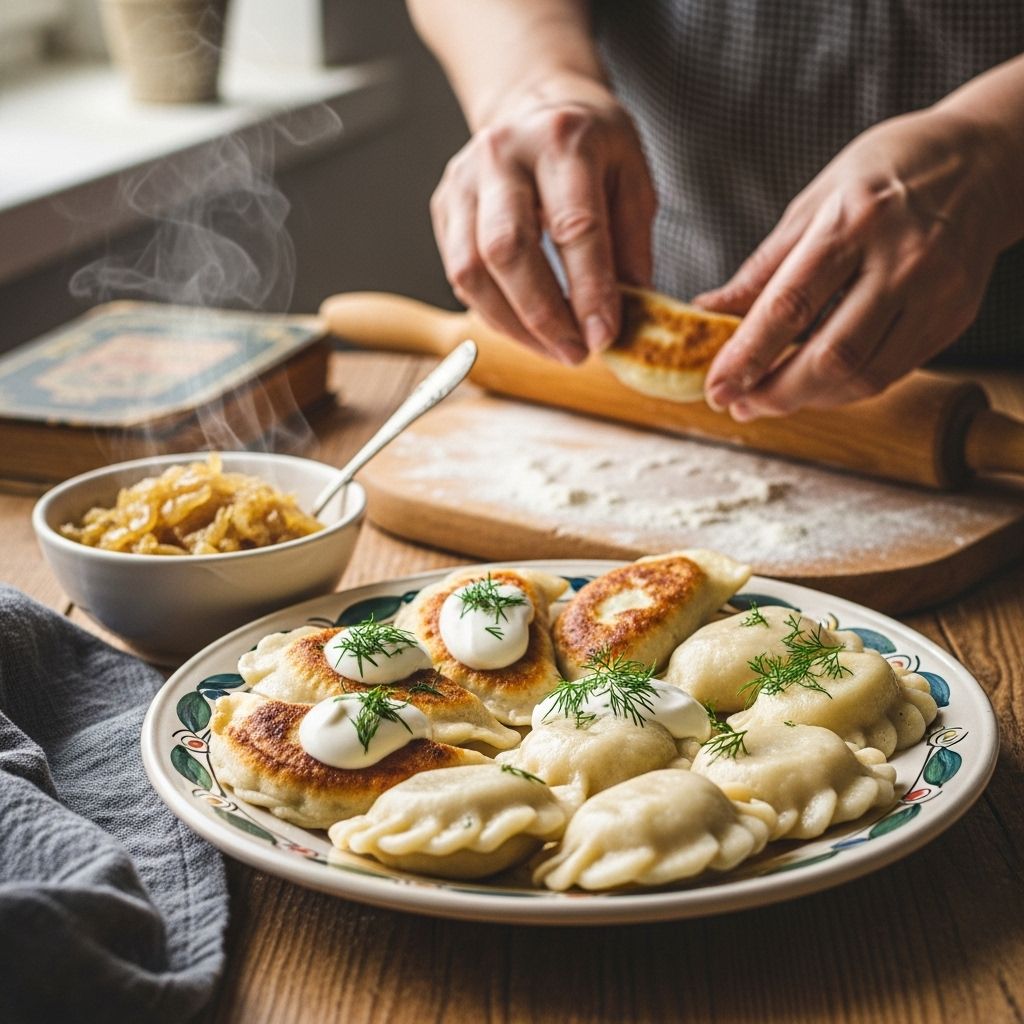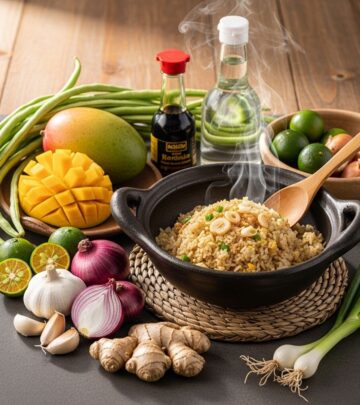Polish Perogies Recipe: Grandma’s Easy Step-By-Step Guide
Discover the heartwarming tradition of homemade Polish perogies, from dough to delicious golden dumplings.

Image: HearthJunction Design Team
Grandma’s Polish Perogies: A Cherished Family Tradition
Nothing brings families together quite like the comfort of homemade Polish perogies. Passed down through generations, this classic recipe transforms humble ingredients into golden, delicious dumplings filled with cheesy mashed potatoes. Whether you’re celebrating the holidays, honoring heritage, or simply looking for the ultimate comfort food, Grandma’s Polish Perogies are guaranteed to deliver warmth and joy with every bite.
Table of Contents
- Introduction to Polish Perogies
- Ingredients Needed
- Preparation Steps
- Making the Perogi Dough
- Preparing the Cheesy Potato Filling
- Assembling the Perogies
- Cooking Instructions
- Serving Suggestions
- How to Freeze Perogies
- Tips for Success
- Nutritional Information
- Frequently Asked Questions (FAQs)
Introduction to Polish Perogies
Polish perogies, sometimes spelled pierogi, are beloved dumplings enjoyed throughout Eastern Europe. Each family has its own special twist, but the classic version is filled with creamy mashed potatoes and cheese, then boiled and optionally sautéed in butter. The tradition of making perogies is as much about the process as it is about the taste—kneading dough by hand, rolling it out, and sharing stories as you seal each dumpling. Homemade perogies are the flavor of family gatherings and the taste of Polish heritage.
Ingredients Needed
Before you begin, gather your ingredients for both the dough and the filling. This recipe uses basic pantry staples, keeping it true to Grandma’s roots.
- Baking Potatoes: 8 large, peeled and cubed
- Cheddar Cheese: 1 cup, shredded
- Processed Cheese Sauce: 2 tablespoons
- Onion Salt: A pinch, or to taste
- Salt and Pepper: To taste
- All-Purpose Flour: 4 1/2 cups
- Salt (for dough): 2 teaspoons
- Sour Cream: 1 cup
- Eggs: 2 whole eggs + 1 egg yolk
- Butter: 1/2 cup (softened)
- Vegetable Oil: 2 teaspoons
Preparation Steps
While the ingredients are simple, making perogies requires some time and attention. Clear your workspace and set aside a couple of hours—these dumplings are a labor of love.
Making the Perogi Dough
- Combine Dry Ingredients: In a large mixing bowl, whisk together 4 1/2 cups flour and 2 teaspoons salt.
- Mix Wet Ingredients: In a separate bowl, blend 1 cup sour cream, 2 eggs, 1 egg yolk, 1/2 cup softened butter, and 2 teaspoons vegetable oil.
- Form the Dough: Gradually add the wet mixture to the flour, stirring until a soft, sticky dough forms.
- Rest the Dough: Cover the bowl with a towel and let the dough rest for 15 to 20 minutes. This allows the gluten to relax, making rolling easier.
Preparing the Cheesy Potato Filling
- Cook the Potatoes: Place 8 peeled and cubed baking potatoes in a large pot. Cover with water and bring to a boil. Cook until fork-tender, about 15 minutes.
- Mash and Mix: Drain the potatoes and return to the pot while hot. Add 1 cup shredded cheddar cheese and 2 tablespoons processed cheese sauce. Mash until smooth and thoroughly combined.
- Season: Sprinkle in onion salt, plus extra salt and pepper to taste. Let the filling cool before using.
Assembling the Perogies
- Divide the Dough: Split the dough into two equal balls for easier rolling.
- Roll Out: On a lightly floured surface, roll one portion at a time to a thickness between 1/8 and 1/4 inch.
- Cut Circles: Use a 3- to 4-inch round cutter or a drinking glass to cut circles from the dough. Gather and reroll scraps as necessary.
- Fill: Place a spoonful of potato-cheese filling in the center of each circle.
- Seal: Moisten the edge lightly with water. Fold the dough over the filling to create a half-moon shape. Pinch the edges tightly or use a fork to crimp and seal. Repeat with remaining dough and filling.
How to Freeze Perogies
- Arrange the shaped, uncooked perogies on a parchment-lined baking sheet in a single layer.
- Freeze until solid, about 1-2 hours.
- Transfer frozen perogies to sealable freezer bags or airtight containers for long-term storage.
- Frozen perogies can be cooked directly from the freezer, no thawing needed.
Cooking Instructions
- Boil Water: Fill a large pot with water, add a generous pinch of salt, and bring to a rolling boil.
- Cook Perogies: Gently lower perogies in batches into the boiling water. Stir to prevent sticking.
- Boiling Time: Boil until perogies rise to the surface, about 5 minutes. Avoid overcooking; remove as soon as they float or they may become soggy.
- Remove: Use a slotted spoon to transfer perogies to a colander or plate.
- (Optional) Pan Fry: For extra flavor and a golden crust, sauté boiled perogies in butter until lightly browned on both sides.
Serving Suggestions
- Serve perogies hot, straight from the pot or pan, with a dollop of sour cream.
- Top with caramelized onions, chopped chives, or crispy bacon bits for added flavor.
- Pair with a simple side salad, sauerkraut, or a bowl of borscht for a complete Polish meal.
Tips for Success
- Keep Dough Soft: If dough becomes dry, cover with a damp towel while you work.
- Sealing: Take care to seal edges firmly to prevent filling leaks during boiling.
- Cheese: Freshly grated cheddar melts better than pre-shredded varieties.
- Butter for Frying: Pan-fry in butter for the best flavor and texture.
- Make Ahead: Freeze extra perogies for a quick meal anytime.
Nutritional Information (approximate per serving, 3-4 perogies)
| Calories | Protein | Carbs | Fat |
|---|---|---|---|
| 320 | 8g | 52g | 9g |
Note: These values are estimated and will vary depending on serving size, exact ingredients, and whether perogies are pan-fried.
Frequently Asked Questions (FAQs)
What are classic fillings for perogies?
The most popular filling is potato and cheddar cheese, but perogies can also be filled with sauerkraut, mushrooms, ground meat, or sweet fruit fillings for dessert versions.
Can I make the dough ahead of time?
Yes! You can make the dough in advance and keep it covered in the refrigerator for up to 24 hours.
How do I prevent perogies from sticking together?
After boiling, toss perogies gently with melted butter or oil to prevent them from sticking. If freezing, freeze in a single layer before transferring to bags.
Can perogies be made gluten-free?
Yes, substitute an all-purpose gluten-free flour blend in a 1:1 ratio. The texture may differ slightly but will still be delicious.
What is the best way to reheat perogies?
Reheat boiled perogies by sautéing in butter or microwaving gently. Frozen perogies can go straight into boiling water for quick meals.
Conclusion
Making Grandma’s Polish Perogies from scratch is more than a recipe—it’s an invitation to connect with tradition and loved ones. Each step, from kneading the dough to sealing the dumplings, carries with it the flavor of heritage and the joy of homemade food. Once you master this classic recipe, perogies will become a cherished staple at your table, ready to be passed down for generations to come. Serve them with pride, and savor every bite!
References
Read full bio of Shinta












